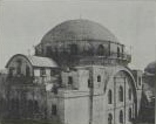Reflections
Rabbi Yehudah the Chasid
Rabbi Yehudah Segal who was famously known as Rabbi Yehudah the Chasid (the pious) led the first Aliyah (immigration, ascending to Eretz-Yisroel) of Ashkenazic Jews (Jews who originate from Central or Eastern Europe) from after the destruction of the Second Temple. Rabbi Yehuda’s entourage included over one thousand Jews.
In the year 5457 Rabbi Yehudah began awakening the hearts of the Jews in his vicinity to ascend to Eretz-Yisroel and to rebuild its ruins. At first thirty families gathered around Rabbi Yehudah and they began their journey towards the Holy Land. They passed through Jewish communities across Europe and at every opportunity he tried to persuade the local Jews to join him and his entourage on their journey to Eretz-Yisroel. Rabbi Yehuda’s words were heartwarming and he managed to convince many Jews to make the decision of moving to Eretz-Yisroel and they joined the group. On the third of Cheshvan, 5461 after a three year expedition during which many of the group members fell victim to various diseases and other harms along the way they reached their destination, the city of Jerusalem. The total number of the group members who actually made it to Jerusalem was a thousand and two hundred consisting of men, women and children.
 |
| Dubno, the city of his birth[צלם] |
Prior to the group’s arrival in the Holy City, the members of its already existing Ashkenazic community excitedly began an overall preparation for the coming group. They built many houses to house the new residents and water wells were dug to meet the growing needs of the growing community. When Rabbi Yehudah’s group started settling in, Rabbi Yehudah realized that a big synagogue needed to be built to accommodate the great number of people. He immediately borrowed money from the local Arabs and purchased a lot in order to build a synagogue on it. It was on this lot that the Shla (Rabbi Yishaya Segal Horowitz) had lived in during the time he resided in Jerusalem. Before the new settlers managed to get familiar with the new surroundings and organized in their new homes, on the 8th of Cheshvan, 5461 their leader Rabbi Yehudah the Chasid unexpectedly passed away at the early age of forty one.
Like a herd without a shepherd the group without their leader and director broke up and many turned back and returned to their homeland. The remaining members of the group were faced with poverty and shortage in addition to the heavy burden of the debt from the lot purchasing they were left with. In order to cope with these financial stresses they sent Rabbi Gedalya of Simiatiz to the Diaspora communities to raise money for the poverty stricken community of Jerusalem.
During his visits to many Jewish centers of population he published a pamphlet called Shalu Shalom Yerushlaim (literally meaning inquire as for the condition of Jerusalem). In the pamphlet he describes the adventures the group went through in their journey to Eretz-Yisroel and the difficult condition in Jerusalem. He also relates the Arab hostility the community is coming across and so he writes “The Arabs are evil towards the Jews and act wickedly to any Jew even in the middle of the street … since we have no permission to raise our hands on any of Islamite or Arab hence they have a pact with the Islamite, and if he (the Arab) hits the Jew so then he (the Jew) goes pleading for mercy, but he says no word against him for fear that he will be hit again since the Jews are despicable. This is the way the Sephardic Jews behave since they are accustomed to this treatment, however the Ashkenazic Jews are not accustomed to tolerating this beating up, they curse back if they know the language or just express they fury… and if a Jew teases an Arab so he hits him disgracefully with his shoe … Jews may not roam around the city streets from a half hour after night falls and if a Jew is found he is caught. This is all besides the penalties.”
From Rabbi Gedalya’s testimony it becomes very evident what a horrible state the Jews of Jerusalem were in. Not only were they suffering financially from debt and poverty, they were suffering from brutal Anti-Semitism as well.
Twenty years later in the year 5481 the Arabs creditors lost their patience waiting for Rabbi Gedalya to return with the money to pay the debt. Arabs rioters rampaged through the Ashkenazi Section and destroyed it totally. The Ashkenazi community was driven out of the city and any Ashkenazi who happened to enter the city gates was required to pay the debt. Several Jews attempted to enter the city disguised as Sephardi Jews. The Ashkenazi Section was called The Hurva (the ruined place), a name which stuck to it till today.
The Ashkenazic community was renewed close to a hundred years later in the year 5576 when a group of the Gaon of Vilnius’ students moved from Zefad to Jerusalem under the leadership of Rabbi Menachem Mendel of Shkolv. This group had sufficient funds to redeem The Hurva and built a magnificent Synagogue on the premises. The Synagogue was destroyed during the six day year during which the old city of Jerusalem was liberated from the Jordanians and its reconstruction is being completed in these very days.






